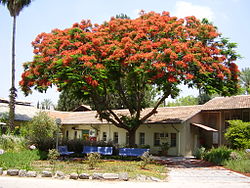Degania Alef
Degania Alef | |
|---|---|
 The original Zionist kibbutz settlement | |
| Country | Israel |
| Council | Emek HaYarden |
| Region | Jordan Valley |
| Affiliation | Kibbutz Movement |
| Founded | 1909 |
| Founded by | Jewish pioneers |
| Population (2008) | 517[1] |
| Website | www.degania.org.il |
Degania Alef (Template:Lang-he-n, D'ganya Alef) is a kibbutz in northern Israel. It falls under the jurisdiction of the Emek HaYarden Regional Council. Degania was Israel's first kvutza, a communal settlement smaller than a kibbutz. It was established in 1909 in Ottoman Palestine.[2] Degania Alef and its neighbour Degania Bet both lie between the southern shore of the Sea of Galilee and the Jordan River.
Name
The name means "cornflower"[3] and is derived from "dagan", meaning "grain".[4] After the first phase at Umm Junieh, the group and its settlement was simply called Degania, "Alef" being added only after the establishment of the associated kibbutzim of Degania Bet and Gimel. Alef, Bet and Gimel are the first letters of the Hebrew alphabet and carry the numeral values 1, 2 and 3.
History

Beginnings
Degania Alef was the first kvutza established by Zionist pioneers in Palestine, then under Ottoman rule. It was founded by a group of ten men and two women[5][6] at a place known in Arabic as Umm Junieh or Umm Juni. Degania Bet was established to the south in 1920.[6]
The poet Rachel Bluwstein, the "prophet of labor" A. D. Gordon, and Joseph Trumpeldor all worked at Degania Alef. Gideon Baratz was the first child born on the kibbutz and Moshe Dayan was the second. Dayan was named after Moshe Barsky, the first kibbutz member killed in an Arab attack.[7] Barsky was killed in November 1913. He was alone in the kibbutz fields when he was shot in the back and left for dead by Arab marauders.[8]
In 1947 Degania Alef had a population of 380.
War of Independence 1948
On May 20, 1948, during the Battles of the Kinarot Valley, in one of the first battles of the 1948 Arab-Israeli war, the residents of Degania Alef and Bet, assisted by a small number of military personnel, repelled a Syrian attack and succeeded in halting the advance of the Syrian army into the Jordan Valley.[6] During the attack Degania Alef was completely destroyed by the Syrian army.[9] According to a 1949 book by the Jewish National Fund, the village was destroyed following attacks on the neighboring kibbutzim of Sha'ar HaGolan and Masada. The settlers resisted, however, and launched a counter-attack which helped to recover the neighboring settlements. Reconstruction started almost immediately.[4]
Economy
In 2007, Degania Alef moved to undergo privatization."[10] Instead of assigned jobs and equal pay under the former communal economy, the reorganization requires members to find employment, live on their income, and allows them to own their homes, but still offers a form of a social "safety net" supplement for members whose livelihood is inadequate to meet their expenses. This move to privatization was chronicled in Yitzhak Rubin's 2008 documentary, Degania: The First Kibbutz Fights Its Last Battle.
Awards and recognition
In 1981, Kvutza Degania Alef was awarded the Israel Prize, for its special contribution to society and the State in social pioneering.[11]
Notable members and residents
- Rachel Bluwstein, national poet
- Moshe Dayan, military man and politician; second child born here
- A. D. Gordon, Zionist ideologist (the "prophet of labor") and pioneer
- Joseph Trumpeldor, Zionist leader, army officer
References
- ^ "Locality File" (XLS). Israel Central Bureau of Statistics. 2008. Retrieved 2010-06-22.
- ^ Adult children of the dream, Jerusalem Post
- ^ http://www.jewishagency.org/places-israel/content/26148
- ^ a b Jewish National Fund (1949). Jewish Villages in Israel. Jerusalem: Hamadpis Liphshitz Press. p. 31.
- ^ http://www.degania.org.il/eng/general.htm
- ^ a b c Yuval El'azari, ed. (2005). Mapa's concise gazetteer of Israel (in Hebrew). Tel-Aviv: Mapa Publishing. p. 125. ISBN 965-7184-34-7.
- ^ Taslitt, Israel Isaac (1969). Soldier of Israel: the story of General Moshe Dayan. Tel Aviv: Funk and Wagnalls. p. 8.
- ^ La Guardia, Anton (2002). War without end: Israelis, Palestinians, and the struggle for a promised land. Tel Aviv: Macmillan. p. 113.
{{cite book}}: Cite has empty unknown parameter:|coauthors=(help) - ^ Martin Van Creveld (2002). The sword and the olive: a critical history of the Israeli defense force. PublicAffairs. pp. 79, 82, 180. ISBN 1-58648-155-X.
- ^ Tim McGirk (2 May 2007). "Postcard:Galilee". Time Magazine.
- ^ "Israel Prize Official Site - Recipients in 1981 (in Hebrew)".
Further reading
- Gavron, Daniel (2000). The Kibbutz: Awakening from Utopia. Lanham, MD: Rowman & Littlefield.
External links
- Official website Template:He icon
- A Day in Degania, from the Steven Spielberg Jewish Film Archive internet site
- Emek HaYarden Regional Council
- Kibbutzim
- Kibbutz Movement
- Israel Prize for special contribution to society and the State recipients
- Israel Prize recipients that are organizations
- Populated places established in 1910
- Jewish villages in the Ottoman Empire
- Jewish villages in the Mandate for Palestine
- Populated places in Northern District (Israel)
